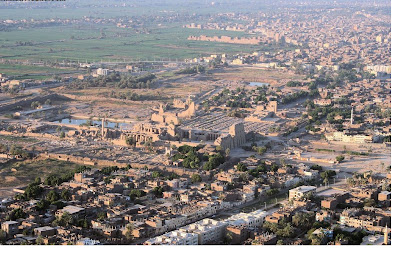 |
| Description of the Temple of Karnak |
Through the central area of five hectares, Diodorus of Sicily has survived as the oldest. nclosing the domain of Amun, south, still unexplored, half its length (nearly nine hectares).
And in connection with the foregoing is the airport cryosphinxes Domin-ion of the goddess Mut, wife of Amon and symbolically represented as a vulture, finally, to the north lies the territory of the Month, god of war, about two and a half hectares.In time left, the dimensions of each exchange complex and the Pharaohs, who ascended the throne in their tracks by the extension of the temple or the addition of rooms and chapels.
The structure of the complex of three saints remains the same: the middle of each room is the most important temple for God and along the east side of the lake of the sacred ceremonies, usually in a square. Among the three complex dedicated to Amun was surprised to find that size.
say it is the largest temple in the world bar and excellent historian might Notre-Dame de Paris included in its entirety, Leonard Cottrell said he was a great monument that it could "almost half the size of Manhattan! Not only, but because of the cover its architecture.
Complexity, which serve as a basis for studying the evolution of species-tic of the Eighteenth Dynasty to the end of the Ramses.
A short path leads to cryosphinxes first and largest round of 113 meters wide and 15 meters, the monumental entrance to the temple, but that without the frills and goes back to the dynasty of the Ptolemies. The ram-sphinxes, to Amun, which protected the god, the Pharaoh, by the legs of the animals.
The court of the first, as we are, as is known, the playground of Ethiopia, IX dynasty and is on the north side is closed by a colonnade fixed locking papyrus capitals, at the foot of the sphinx of Ramses II in order under the entrance to the portico are . The Couryard is dominated in the middle by a tall column with a column of the open papyrus, but the remains of the huge banner of the Ethiopian king Taharka, 21 meters high and with a wooden roof to protect the sacred vessels.Compared to the right column to get to the temple of Ramses III, with its courtyard on three sides by columns of Osiris, where Pharaoh is surrounded costume for retirement under.
Supported by the second tower, a giant statue was made of granite is a statue of Ramses II and 15 meters high is the king Pinudjem. The portal of 29.5 meters, leads to what one of the greatest works of art from ancient Egypt: the colonnade, measuring 152-3 meters, with - forever challenging times - 134 columns 23 meters.
The open papyrus - shaped head of the capital, as above, could take over a circumpherence about 15 feet, which were 50 people. This is a forest of columns, their size and play of light and shadow to create so many emotions.
The central aisle, began around 1375 BC in Amon-Ofis III, designed as a simple colonnade in the Temple of Amun, has shown a different height and side, which began passed under Horemheb, Seti I and Ramses II and eventually completed Ramses IV
This large difference in height allows the introduction of the "cloister" great work window in the sandstone that offer some kind of eerie light.Beyond the portico, is the obelisk of Thoth I Moses, 23 meters high and weigh 143tons used, unfortunately, only one remains. Is surpassed in height of the obelisk Hatshep sut, the 30 meters high and weighs 200 tons. In view of its construction, the Queen spared no expense, because the new chronicle of the time, paid in ", as bushels of wheat bags of gold."
After passing the fifth and seventh pylon (or Thot Thot I and III of Moses, Moses), one arrives in this strange environment that Aj menu Thoth Moses III, Palais des Festivals is also known as the Temple "million years."
This is a beautiful hypo-style hall with two rows of ten columns with their axes of dark-painted to imitate wood and decorated a series of thirty-two square pillars with scenes. A few traces of color brought out of the century to some of the columns, we say that this room was in a church of Christian monks converted light.
The Holy See areas of Amun was 120 meters by 77 meters and is surrounded by buildings, shops, houses of priests and even an aviary for aquatic birds. In these waters, the priests used every morning before beginning his daily sacred rites to clean.
It is amazing that man could be a large and impressive building complex to build, on the other hand, we know that worked under the nineteenth dynasty, 81 322 people in the Temple of Amun, the priests, guards, workers and peasants. In addition, the church has earned income and a large number of places, markets and gardens, the wealth of all improved and the loot that Pharaoh received military victories.



_optimized.jpg)
No comments:
Post a Comment